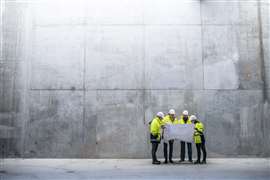Read this article in Français Deutsch Italiano Português Español
EU’s construction strengths and weaknesses revealed
11 June 2024
 A residential housing project in the Netherlands under construction. European construction activities are contracting, particularly on weak growth in the new housing sector. (Image: Adobe Stock)
A residential housing project in the Netherlands under construction. European construction activities are contracting, particularly on weak growth in the new housing sector. (Image: Adobe Stock)
The European Construction Industry Federation (FIEC) released its 67th Statistical Report, and although the data suggests each of the European Union’s (EU) 27 countries – in addition to Norway, Switzerland, and Ukraine (EU27-plus) – have their own unique strengths and weaknesses in the construction industry, the continent has been hampered overall by a declining residential build segment.
FIEC’s report shows more than three million enterprises compile 12 million labourers to operate in the region. Of those three million companies, 95% are staffed with less than 20 workers. Across the EU27-plus countries, the sector represents 5.5% of total employment and 48.7% of GFCF (gross fixed capital formation).
The report also shows that new housebuilding and residential renovations still take up most of EU27-plus construction activities; an aggregate of 50.2% in 2023, with renovations consuming 30.3% of that total.
Non-residential construction was the highest of the four single categories tracked by FIEC; it accounted for 31.8% of activity in 2023.
Overall, European construction is contracting
“Looking at individual member states, the picture is bleak across most of Europe, with the construction sector in most countries experiencing either weak growth or contraction,” says FIEC, which adds the reductions reached “crisis” levels in 2023. “Projections for 2024 are rather pessimistic across most of Europe.”
While the Euro recorded 2023 growth of 0.4% and employment increased slightly (0.3%) in the year’s final quarter, FIEC’s report notes that real GDP growth in the EU was more modest than projected; it increased 0.4%, which was half the 0.8% projection.
“The construction sector in Europe, which has proved more resilient than other sectors in previous economic downturns, is expected to contract by 2.3% in 2024,” says FIEC. “Total investment in construction started to slow down in 2022, contracting by 0.3% last year.”
The report cites Bulgaria (-9.8%) and Sweden (-5.6%) as having the largest pullback in 2023.
“In the case of Sweden, this is mainly due to the ongoing crisis in housing construction,” says FIEC.
Dip in residential building a thorn for Europe
Regarding new home builds, Rüdiger Otto, chairman of the FIEC Economic and Legal Commission, says, “The outlook is particularly gloomy in the Nordic countries.
“In many EU countries, companies have complained that government measures to tackle the housing crisis have so far proved insufficient,” he adds.
The starkest reduction in activity is in new housebuilding, which – after reaching record high investment from 2021 through 2022 – has fallen to its lowest level since about 2017.
New housebuilding last year is expected to have fallen 6.2%, and 2024’s hopes are worse; an 8.6% reduction is anticipated by year’s end. Even including renovation statistics, the entire residential segment is presumed to fall 2.9% and 5.8% in 2023 and 2024, respectively, says FIEC.
As mentioned, Sweden’s homebuilding industry has been particularly hampered, “registering a decline of 37.2% in new residential construction last year,” says FIEC.
“Government measures have proved insufficient and ineffective to combat the crisis in residential construction and small companies in this segment are failing,” the report adds. “In addition, many companies are moving to other segments. A similar situation can be observed in Finland, where the segment shrank by 36% last year and the number of residential permits fell by 50%.”
Denmark (-13.8%) and France (-8.0%) were two regions FIEC says are “worrying.”
“The crisis in residential construction, which accounts for a fifth of the construction sector, has the potential to have a negative impact on employment in the sector,” says Otto. “In some EU countries, the number of people employed in the sector is falling. In addition, small enterprises are leaving the sector in some EU countries.”
Is there anything to look forward to in European construction?
While the overall picture of European construction activities is striking a sombre tone, FIEC says there are several glimmers of hope that could offer a course correction in the coming years.
“[The renovation segment] has the potential of becoming a substantial driver of growth for the construction sector in the longer term as the renovation of buildings is being put at the heart of European and national climate policies,” says FIEC. “In the short term, it could act as a counterbalance to new residential construction, as demand for renovation and maintenance and government support for sustainability measures could make this segment less vulnerable to economic cycles. The figures suggest that renovation mitigated the decline in residential construction.”
Some overall segments did manage progress, as the civil engineering segment, says FIEC, grew by 3.8%, and an additional increase of 4% is expected for 2024.
Non-residential construction also grew, albeit modestly, at 1.5%. The segment is projected to remain flat in 2024.
The report also highlights some strength segments for specific regions.
“Italy and Spain proved more resilient, with growth of 1.3% and 2.1% respectively,” says FIEC on the housing sectors in those two countries. “Greece has seen the highest growth [overall] in 2023 (+21.2%), partly due to the implementation of projects under its Recovery and Resilience Plan.”
The Czech Repulic (8.2%) and Lithuania (11.9%) show trending growth on the whole, as well. Also, the construction sector in Bulgaria – despite three consecutive years of contraction – is expected to turn around by 19.6% this year.
STAY CONNECTED


Receive the information you need when you need it through our world-leading magazines, newsletters and daily briefings.
CONNECT WITH THE TEAM











